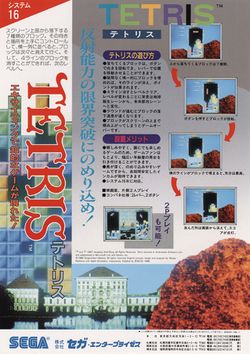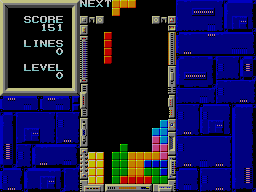
| Tetris | |
|---|---|
| Developer(s) | Sega |
| Publisher(s) | Sega |
| Year released | 1988 |
| System(s) | Arcade, Sega Genesis |
| Series | Tetris |
| Genre(s) | Puzzle |
|---|---|
| Players | 1-2 |
| Modes | Single player, Multiplayer |
Tetris (テトリス?) is a 1988 Sega System 16 arcade game developed and published by Sega. It was licensed from Atari Games (credited as Tengen) and Mirrorsoft, who held the rights to produce Tetris arcade games at the time. This version of Tetris took Japanese arcades by storm, becoming one of the most commonly known versions of the game. Due to its popularity, it became the base of rules for many other Japanese games created later on, both licensed and unlicensed, including Tetris Plus and the TGM series. It was one of the first games to introduce lock delay, improving maneuverability greatly at high speeds compared to games which did not have the feature.
Sega also released versions of this game on Taito's B-System and H-System arcade boards in Japan. The B-System versions were released as upgrade kits for Taito's Nastar and Master of Weapon; the H-System version appears to have been sold on modified boards that previously held Taito's Go for the Gold (released overseas as Recordbreaker) rather than as an upgrade kit. A less powerful version was also released for 8-bit Sega System E hardware. Both versions are unrelated to Atari's arcade version, released in the same year under the same name.
A fairly accurate representation of the game, along with Tetris: New Century, Flash Point and Bloxeed, can be obtained in the Japanese PS2 game Sega Ages 2500 Series Vol.28 Tetris Collection.
-
Title screen
Gameplay[edit]

Being an early game, there was only one rotation button, which rotated counterclockwise. The game also contained no wallkicks and no hard drop. However, many of the elements that exist in later games can already be seen here, such as delayed auto-shift movement, lock delay, entry delay, and rotation/movement processed before gravity. One rule element not commonly seen in recent games is the existence of the field ceiling. The field height is fixed at 20 cells, and any rotation that would exceed that height would fail.
It was one of the first games released in Japan to popularize the "marathon" play model of playing endlessly against increasing speed for survival, as opposed to beating levels or clearing a predefined number of lines ala Atari's own Tetris for arcades.
There are 2 ways to increase a level:
- Erase 4 lines.
- Put any tetromino after the "level timer" reaches to certain value. (Level will not increase if line clear happens.)
The "level timer" will increase every 256 frames. For most levels, the timer must reach nine, except for levels 0, 9, 10, and 15, where the timer must reach fourteen. If the level increases, the timer will be reset to zero.
Power-on Pattern[edit]
One characteristic of this version of Tetris was the existence of a "power-on pattern". This referred to the game's behavior that the string of pieces it dealt in the very first game after starting up the system was always the same. This was most probably caused by the state of the randomization seed in the system. After its discovery, players began constructing gameplay plans around the power-on pattern in order to max out the score in the least lines possible. Sega Tetris, Sega's 1999 version of Tetris (Arcade, Dreamcast) pays tribute to the power-on pattern, by dealing the sequence in the final level of the single-player game.
For MAME players, unless you are playing the bootleg, you must delete your nvram before playing to get the power-on pattern. The B-system version has a different power-on pattern, and does not require you to delete your nvram. It even restores the pattern upon reset, which not even the bootleg will do.
Flash Point also contain a power-on pattern, and uses it for every level you play for the entire game, and if you continue. If you fail to continue, the next game continues where the failed level ended in the power-on pattern. Again, unless you are playing a bootleg without nvram, you must clear the nvram to get the power-on pattern back.
Bloxeed contains a power-on pattern as well. Additionally if you "continue" you will recieve the pieces in the same order again. However, the powerups are NOT included in the power-on pattern, and are truly randomized.
Mega Drive version[edit]

Sega ported the game to the Mega Drive, however they cancelled the title's release. Although Sega never gave a reason for cancelling the title, there would have been potential legal issues with releasing the game. Around this time, Nintendo had sent a cease-and-desist notice to Atari Games (who had sub-licensed some of their Tetris "rights" to Sega through their home game division, Tengen) regarding console rights to Tetris. As such, only about 10 cartridges were produced, all of which were only released in Japan. This version is now a rare collector's item, being sold in auctions for up to US$16000. Sega could still release Tetris-themed arcade games, however, and the Mega Drive port was brought to Mega-Tech hardware in 1989.
This conversion is fairly accurate to the arcade version. However, it does alter the look of the blocks somewhat. It also contains some other features such as level and height settings, the ability to toggle the next piece on and off, as well as the ability to toggle on the special item blocks feature. When turned on, certain flashing blocks fall which, if used to clear lines, will grant special bonuses. The game also features a timed mode, two player competitive modes, and a two play cooperative mode where players must work together to drop two pieces simultaneously in a single matrix.
Game modes[edit]
- 1 Player
- Normal Game: Endless mode.
- Time Trial: 3 minute mode.
- 2 Player
- Normal Game: Endless mode, each player get the pieces in the same order. Players do not "attack" one another for completing more than one line at a time.
- Time Trial: 3 minute mode, each player get the pieces in the same order. Players do not "attack" one another for completing more than one line at a time.
- Doubles: Endless cooperative mode where each player controls one of two pieces in a Matrix that is 12 blocks wide instead of 10.
Game options[edit]
Before each game, you can configure the difficult through the following options:
- Level: Choose your starting level (0 through 9).
- Height: Choose the height of a starting amount of "garbage" lines (0, 4, 7, 10, or 13).
- See next block: Yes or No. You cannot change this setting in the middle of the game.
- Use item blocks: Yes or No. When enabled, special flashing blocks fall periodically. If you use them to complete at least one line, a special effect or bonus is applied.
You can also access a control configuration menu by pressing ![]() on the title screen, which allows you to configure the controls, and map what function each button performs.
on the title screen, which allows you to configure the controls, and map what function each button performs.

